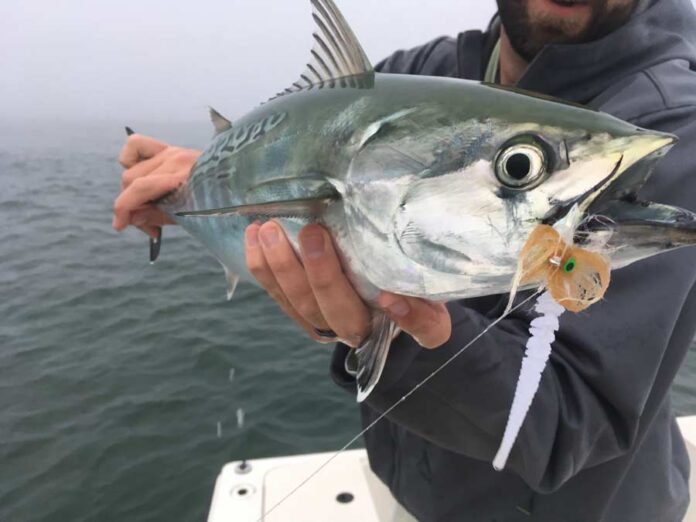Welcome to the latest installment of the Wednesday Wake-Up Call, a roundup of the most pressing conservation issues important to anglers. Working with our friends at Trout Unlimited, Backcountry Hunters & Anglers, the Theodore Roosevelt Conservation Partnership, The Everglades Foundation, Captains for Clean Water, VoteWater.org, Bonefish & Tarpon Trust, and Conservation Hawks (among others), we’ll make sure you’ve got the information you need to understand the issues and form solid opinions.
1. Groundbreaking Study of False Albacore Migrations Yields Remarkable Results
This time of year, inshore anglers in New England are flocking to the coast in hopes of connecting with an iconic inshore species we knew very little about—until recently. Albies have a cult following throughout the Atlantic coast, and for inshore light-tackle and fly anglers, there aren’t many species that put up the pound-for-pound fight that false albacore do.
Unfortunately, there is no management or scientific understanding for this species important to coastal communities throughout much of the Atlantic coast. The American Saltwater Guides Association collaborated with the New England Aquarium to plan and execute the first-ever telemetry tagging campaign for Albies. The first season was incredibly efficient, and the initial results were astounding; 61 of the 63 acoustic-tagged fish pinged throughout the following months. Once the water in Nantucket cooled, the albies headed down to Rhode Island, Long Island, and offshore of Southern New England. In all, 34 albies were detected outside of the original area. 21 out of the 34 appeared in waters off the coast of North Carolina throughout the winter. Even more amazing, 5 of those were detected off the Florida Keys in the spring. Over 60% of Massachusetts-tagged fish pinged throughout the southeast. All signs point towards one connected coast for false albacore.
Click here to learn more about the latest findings from ASGA and the NEAQ
2. A Bipartisan Group of Alaska Legislators Support Bristol Bay Protections
Photo courtesy Pat Clayton, Fish Eye Guy Photography
On many conservation issues, Republicans and Democrats line up on opposite sides of the debate, but in Alaska there’s one thing many customary opponents can agree on: Pebble Mine must never be built. Writing in the Alaska Current, a bipartisan coalition of 22 state legislators, representing both parties, has come out against the Attorney General’s lawsuit against the U.S. Environmental Protection Agency over its final determination halting the Pebble mine:
As lawmakers, we are deeply concerned with your decision to petition the U.S. Supreme Court to overturn the Environmental Protection Agency’s veto of Pebble Mine. We believe this action is misguided, goes against the will of Alaskans, and is contrary to the best interests of our state and its people.
According to a 2020 poll, two in three Alaskans are opposed to the Pebble Project. Alaska Native Tribes, fishermen, business owners, conservationists, and everyday Alaskans have all voiced concern about the impact Pebble Mine would have on Bristol Bay.
Click here to read the full letter on thealaskacurrent.com
3. New Video Looks at Sage Grouse and Habitat Loss
While this video is long, it’s full of fascinating information about this iconic Western species and its struggles to endure loss of habitat:
This native upland game bird is the canary in the coal mine for the sagebrush landscape it calls home. Sagebrush habitat loss due to a variety of threats could place the sage grouse on the endangered species list affecting western public lands the size of Texas! Join Wingmen Todd Helms and Ike Eastman as they explore the story of the sage grouse. This film aims to open the eyes of the American public to an issue they are likely completely unaware of, but could have a real impact on their day to day lives.
Click here to learn more about this issue on trcp.org
4. Act Before Sunday to Help Rebuild Louisiana’s Redfish Stock for the Future

Photo by Irene Kato
Louisiana is considering the first regulation change for redfish since 1988. For a state not known for proactive fisheries management actions, the proposed changes currently on the table are historic. The population of redfish in the state has fallen from an estimated 23 million to 8.7 million fish. Substantial changes are required to ensure legendary fishing for generations to come.
The new proposal would rebuild this iconic population in only 12 years (as opposed to almost 30 years). While Louisiana still offers the best redfish angling in the world, we must address this situation quickly. With every season that passes, the situation will become more difficult to repair. A community of Louisiana guides is calling for everyone from around the country to support these changes—you can do so by visiting the ASGA website and signing the official letter to the state on behalf of yourself and/or your business.
Time is short. Don’t wait: Comments must be submitted by October 1, 2023.
Click here to learn more and sign the official letter
Credit: Source link






























